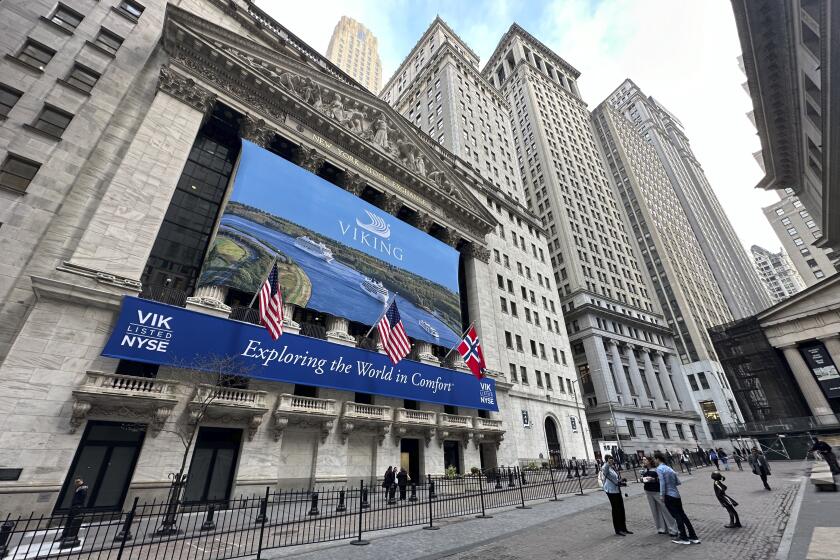Half of All S&Ls; May Disappear in Coming Years : Lenders: Large institutions are likely to dominate, experts say on the first anniversary of the thrift bailout law. The line between thrifts and banks is expected to continue to blur.
The savings and loan industry--in the throes of a mass shakeout--will be increasingly dominated by huge institutions that successfully keep costs low. But they may not be S&Ls; for long.
That’s the view of several S&L; executives and observers who were interviewed in connection with this week’s one-year anniversary of the federal S&L; bailout bill. As many as half the thrifts now operating, they say, won’t survive. Others will leave the industry because new rules under the rescue bill make it too hard to make money.
The list of survivors will be dominated by a few larger mortgage lenders who can cut costs efficiently and thus improve their competitive position in a home-loan market characterized by increasingly thin profit margins. But while these big lenders will largely stick to thrifts’ traditional business--making home loans--others will seek to diversify their loan offerings and become more like commercial banks. And small thrifts will survive by serving specialized markets or providing personalized service.
Consumers generally should benefit from the changes, because the survivors will be more efficient and financially stronger, industry experts say.
Just who will survive, of course, is uncertain. But some S&L; executives, seeking to ensure their place, have already set the wheels of change in motion. Among them:
* Both Irwindale-based Home Savings of America and Oakland-based World Savings, two of the nation’s most profitable thrifts, are cutting costs.
“Everyone will tend to get more efficient,” said Richard H. Deihl, chairman of Los Angeles-based H.F. Ahmanson & Co., parent of Home Savings. The unit plans to trim its overhead by 7% by the end of this year.
“It’s not a question of cutting expenses. We will try to increase productivity,” said Herbert M. Sandler, chairman and co-chief executive of Golden West Financial, parent of World Savings. It plans to further reduce its administrative expenses, already the lowest among major thrifts at 0.96% of its average asset level.
* International Savings Bank, a small, single-office thrift in San Diego, is diversifying its product mix. It will open four more branches over the next three years and switch from making exclusively real estate loans to other consumer loans, while striving to establish “consumer relationships” with depositors.
“What’s going to be different is that our strategy will be to do more retail banking,” said President Vincent Siciliano.
* Downey Savings, a Newport Beach-based S&L; with 49 branches, most located in shopping centers it developed, is adjusting to new rules. It is selling off all its commercial real estate portfolio because of restrictive new S&L; capital requirements. Meanwhile, the thrift recently hired a Bank of America executive to help redirect its market strategy to consumer loans.
However, even if these and other S&Ls; survive and prosper, it’s not clear that they will remain savings and loans.
The increasing S&L; failure rate, banks’ growing share of mortgage lending and tougher rules in the bailout legislation are all working to accelerate the blurring between banks and S&Ls; that has been under way for nearly a decade, analysts say.
The end result will be the eventual elimination of savings and loans as “a separately regulated industry,” predicted Bert Ely, an Alexandria, Va., consultant. Ely and others see a day soon when banks and S&Ls; will be subject to the same accounting rules, capital requirements and asset-deployment requirements.
“The reality is, you will see the dissolution of the S&L; industry as we knew it and the emergence of a kind of bank that makes mortgage loans,” said William D. Davis, commissioner of the California Department of Savings and Loan. “You can see it happening now, where you have Wells Fargo taking over Great American Bank branches. All those branches will soon look like and be banks but compete for home mortgages.”
The savings and loan industry had been shrinking long before the tough requirements of the thrift bailout legislation kicked in last year after the law was signed by President Bush on Aug. 9, 1989. Failures and consolidations had reduced the number of S&Ls; nationwide by the end of 1989 to 2,914 from 3,998 at the end of 1980, according to the Federal Home Loan Bank of San Francisco.
The growing stigma of the S&L; business, the intense scrutiny of government auditors and onerous financial requirements of the thrift rescue legislation are expected to chase another 1,000 or more S&Ls; from the business over the next five years. Golden West’s Sandler said the number of S&Ls; could fall to below 1,000 once the dust settles.
Many of those reductions will occur through government seizures. Up to 600 financially weak S&Ls; are under threat of regulatory takeover. But executives at some healthy thrifts say the industry, for several reasons, is no longer an attractive business.
First, there are the higher deposit insurance premiums that S&Ls; pay to the government to offset the huge cost of the S&L; cleanup. S&Ls; now pay a premium of 0.2% of deposits for insurance, more than twice the .08% premium that banks pay for deposit insurance. S&Ls; will soon be subject to rules that stipulate that 70% of all loans be secured by residential real estate, which many lenders find restrictive, particularly those that have made money investing and lending on commercial real estate.
Added disincentives are the intense scrutiny of the industry by the Office of Thrift Supervision’s auditors and the stigma of being part of an industry under siege. Last but not least are the higher capital requirements for S&Ls; being phased in by the thrift law.
“You get audited to death, everything looks suspicious and they want to make sure that in every nuance of the business, the i’s get dotted and the t’s get crossed,” said Siciliano of International Savings.
“The combination of the higher capital requirements, the high deposit insurance premiums and the limitation on non-mortgage investments make it uneconomic for the average S&L; to remain in the business,” said Andrew S. Carron, manager of mortgage research at the New York investment firm First Boston Corp.
Several industry figures expect the home loan business to be dominated in coming years by “megathrifts” such as Great Western Bank, Home Savings and World Savings, three California S&Ls; that so far have weathered the S&L; crisis with their images and asset quality intact.
All three have stuck almost exclusively to residential mortgages--each has 80% or more of assets in home loans--and have largely resisted investing in junk bonds, commercial real estate development and other non-traditional investments that lured so many S&Ls; to their doom.
“There are going to be a heck of a lot less charters, fewer people but larger ones,” said Deihl of Home Savings, which currently has 94% of its assets in residential loans. “Those that survive will have to show greater efficiency, and the way you get that is mass. It’s easier to run $1-billion assets than $10-million assets. You can afford to have specialists, better utilization of time, more advertising.”
Pointing to the success of Home Savings and others, Jerry Hartzog, chief financial officer of the Federal Home Loan Bank of San Francisco, said he expects certain institutions to continue to specialize in home loans, despite the blurring between banks and S&Ls.;
“There has been a lot of talk by so-called experts that home financing is not profitable and that you have to get into other things and that any firm that does only home mortgages is doomed,” Hartzog said.
“But the most successful S&Ls; are the ones that stuck to home finance. Despite the glamour of broadly diversified firms, the ones that tend to be successful are those that figure out what they are good at and specialize at it. That’s true of mortgage lending institutions.”
What’s in it for consumers?
They “have no reason to mourn (because) housing finance is becoming increasingly efficient,” consultant Ely said. “The spread between deposit and loan rates is narrowing. It’s like the difference between the corner store or the supermarket. Supermarkets operate on a narrower profit margin, so things are cheaper.”
Apart from cutting costs to compete in the new low-margin environment, surviving thrifts are looking to get into new lines of lending, particularly consumer loans secured by real estate, said Douglas J. McEachern, national director of the S&L; consulting practice at Deloitte & Touche, an accounting firm.
International Savings Bank, which until recently made only real estate loans, will soon be offering home equity lines of credit, automobile loans, bank credit cards--”a bunch of products that take care of consumers’ needs,” Siciliano said.
International Savings’ shareholders took out a thrift charter in 1984 because of the small capital requirements relative to those of banks and because of tax incentives that made real estate development and lending attractive, Siciliano said. Now that those advantages are gone, “there is no reason we shouldn’t convert” to a bank charter, he said.
Even healthy S&Ls;, such as Downey Savings, are repositioning themselves. Downey recently hired David L. Boyles, former head of Bank of America’s retail banking operation, as chief executive--to help it develop new markets.
“My view is when you can’t beat ‘em, you join ‘em,” said Downey Chairman Maurice McAlister, referring to banks.
“When you don’t make the rules, you have to try to interpret what’s going on and move accordingly. The way I interpret the rules at the present time, the people that the government is listening to are primarily commercial bankers. That being the case, they have the power, and you have to switch your operation more toward a commercial bank.”
Carron said S&Ls; have had to deal with increasingly stiff competition from banks in the mortgage loan market as banks have realized that mortgages are a “very desirable and efficient asset to own, what with all the problems in (foreign) loans, junk bonds and commercial real estate.”
To illustrate, Carron said, at the end of last year, banks held 29.2% of the $3.2 trillion in U.S. residential mortgages outstanding, compared to 34.7% held by S&Ls; and savings banks. But banks’ mortgage holdings increased 7.4% during 1989, while S&Ls;’ holdings declined by 8.1%. The reduction was due in part to the necessity of S&Ls; to shrink assets to meet new capital requirements.






